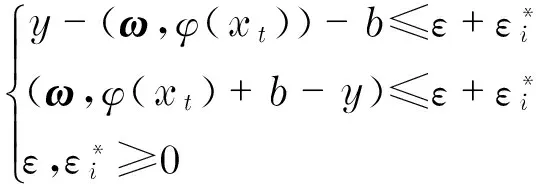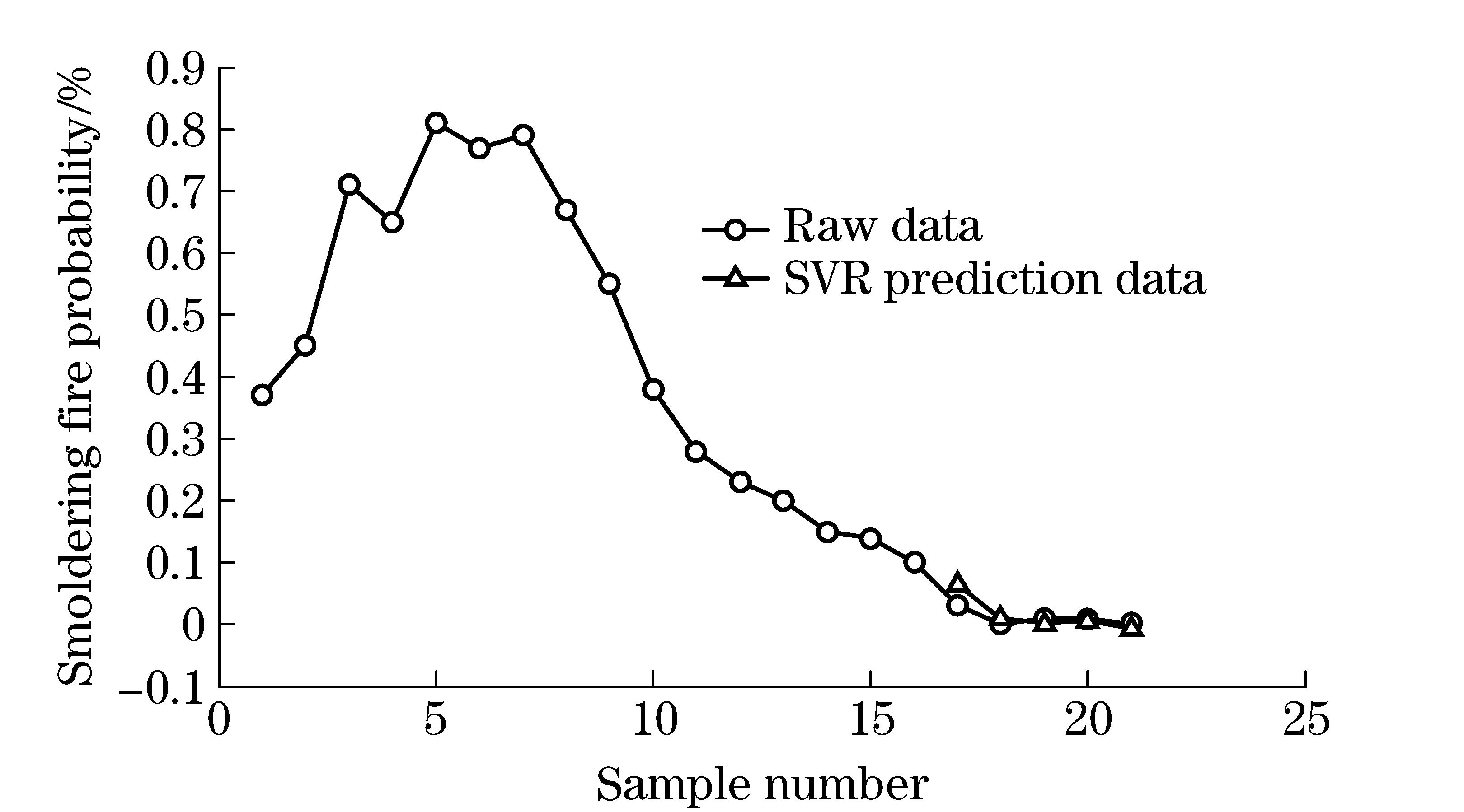High-rise building fire pre-warning model based on the support vector regression
ZHANG Li-ning(张立宁), ZHANG Qi(张奇), AN Jing(安晶)
(1.State Key Laboratory of Explosion Science and Technology, Beijing Institute of Technology, Beijing 100081, China;2.Architecture Engineering College, North China Institute of Science and Technology, Beijing 101601, China)
High-rise building fire pre-warning model based on the support vector regression
ZHANG Li-ning(张立宁), ZHANG Qi(张奇)1, AN Jing(安晶)2
(1.State Key Laboratory of Explosion Science and Technology, Beijing Institute of Technology, Beijing 100081, China;2.Architecture Engineering College, North China Institute of Science and Technology, Beijing 101601, China)
Aiming at reducing the deficiency of the traditional fire pre-warning algorithms and the intelligent fire pre-warning algorithms such as artificial neural network, and then to improve the accuracy of fire pre-warning for high-rise buildings, a composite fire pre-warning controller is designed according to the characteristic (nonlinear, less historical data, many influence factors), also a high-rise building fire pre-warning model is set up based on the support vector regression(SVR).Then the wood fire standard history data is applied to make empirical analysis. The research results can provide a reliable decision support framework for high-rise building fire pre-warning.
high-rise buildings fire; composite fire pre-warning system design; the support vector regression pre-warning model
High-rise buildings are the inevitable products of the city development, but their fire safety issues are always important in the world. At present, take China as an example, the fire ladders can reach the height of generally not more than 100 m, so in the event of a fire, high-rise building often suffered heavy losses. According to statistics, from 2004 to 2010, the high-rise building fire occurred about 100 thousand cases (daily average about 40 cases) in China, which caused the death of 4 181 people, 4 844 people were injured, the direct economic losses were amounting to 14 billion yuan[1]. In recent years, the casualties and property loss caused by the high-rise building fire is increasing, for example, the “11. 15” fire of Shanghai Jing’an district in 2010 is resulting in 58 deaths, 71 people were injured, 10 million yuan economic losses. And the Ryder commercial fire of Tianjin in 2012, 10 people were killed, 16 injured and so on. At present, the prevention and control of high-rise building fire has become a serious social problem.
Therefore, if we can develop a new intelligent fire warning model, it will have very important and practical significance to improve the accuracy and reliability of the high-rise building fire warning system, and to minimize the fire accident loss. At present, concurrent studies of the fire pre-warning are mainly focus on the system hardware development both in domestic and foreign research institutions, however, due to the lack of sufficient data and the corresponding analog simulation tools, the pre-warning algorithm (which is the core for fire warning software) research progress is slow, thus causing the warning results inaccurate, and the warning system reliability poor.
The early study on fire warning algorithm is direct method[2], after 1980s, professor H. Luck put forward the trend algorithm and filtering algorithm, by using the correlation of fire signal, to distinguish the difference between fire and non-fire signals for fire warning. R.Siebel proposed the composite trend algorithm according to the trend correlation of different fire sensor signal. And through the application of statistical characteristics of fire signal, J.Klose proposed the fire detection signal processing algorithm based on the fire signal short-time autocorrelation function or power spectral density[3-4].
But the threshold algorithm and trend detection algorithm, can only process the single detector signal, if applied to the multi-parameter system, often make false alarms and omissions. With the emergence of intelligent algorithms for information processing, many scholars began to introduce the intelligent algorithm into the fire pre-warning process, to reduce the rate of missing alarm and false alarm. The most representative one is the artificial neural network(ANN), in 1994, Switzerland Cerberus launched the first Algorex fire alarm to market by using neural network prediction algorithm. And Y. Okayama developed ANN pre-warning algorithm for different fire signals, for example, the three layer neural network and back propagation algorithm[5-7].
The domestic study on the fire pre-warning algorithm began relatively late, and obtained some research results. For example, Wang Shu put forward a specific compound trend algorithm[8], Zhang Jian brought about the fire pre-warning algorithm based on feed-forward neural networks[9]. Tang Qunfang developed the fire warning algorithm based on fuzzy logic and neural networks[10].
To some extent, the above warning algorithms reduced the shortcomings of traditional warning algorithm, and improved the reliability of pre-warning system. But research shows that, in the case of small samples, the ANN usually can not be fully trained, so the warning effect is not ideal, and the ANN algorithm has the problems such as dimension disaster and over learning et al. In view of this, this study introduced support vector machine (SVM) algorithm into fire pre-warning, SVM is an intelligent non-parametric estimation algorithm for limited samples, and has superior performance in solving small sample, nonlinear and high dimensional pattern recognition problems[11-12]. But study found that the application of SVM in regression prediction and high-rise building fire pre-warning is less.
Therefore, according to the characteristics of high-rise buildings, such as complex function, large fire load, the fire spread quickly, etc., and the characteristics (nonlinear, less historical data, many influence factors) of the high-rise building fire pre-warning system, to improve the accuracy of the high-rise building fire pre-warning, one key is to establish a reliable and intelligent pre-warning model. So in the study,a high-rise building fire pre-warning model set up based on the support vector regression(SVR), through the Matlab simulation, to provide a reliable decision support system for high-rise building fire pre-warning.
1 Composite and intelligent fire pre-warning system establishment for high-rise building
1.1 Composite fire pre-warning system design
The purpose of fire pre-warning system is to discover the fire as soon as possible, not only just to detect a single smoke or temperature signal. Research shows that, the smoke signal and temperature signal are complementary good, their combination can overcome the shortcomings of smoke detector whose smoking-spectrum range is narrow, and also solves the disadvantages of temperature sensing detector with low sensitivity. Also compared with other fire signals (such as smoke, temperature, flame, gas etc.) in a compound form, the combination is of simple structure, signal intuitive, and low cost etc. So this study designs a composite fire alarm controller composed of the smoke detector and the temperature detector, the pre-warning system diagram is shown in Fig.1.

Fig.1 Composite fire pre-warning system diagram for high-rise building
1.2 SVR pre-warning model implementation
The support vector machine(SVM) proposed by Cortes and Vapnik in 1995, is a new data mining technology, which can overcome the deficiency of traditional algorithms, for example, the dimension disaster, the over learning et al. At present, SVM has been widely used in various fields both abroad and home, the support vector regression(SVR) is an improved SVM[13-14]. The relationship between the fire signal and fire probability is very complex for high-rise building, it is difficult to use a specific model to describe. This paper is using the SVR pre-warning model to build the relationship between the fire signal and the fire / smoldering fire occurrence probability, that is, set the smoke signals, the smoke rising rate signals, the temperature signals and the temperature rising rate signals 4 factors as network inputs, the fire occurrence probability and the smoldering fire occurrence probability respectively as the network output, to establish a SVR pre-warning model with multiple inputs and single output for high-rise building fire pre-warning, as shown in Fig.2.

Fig.2 SVR model for high-rise building fire pre-warning
The modeling idea is to make the input signal value (x1,x2,…,xm) mapped to a high dimensional feature space (φ(x1),φ(x2),…,φ(xm)).Thenthenonlinearmodelistransformedintoalinearregressionmodel,whichisgivenbythefollowingequation:
f(xj)=ωTφ(xj)+b
(1)
whereω,bis model parameter to be identified, deal with the parameter in Eq.(1), the result is:
(2)
whereRemp(f) is the empirical risk, ‖ω‖2is the trust risk,C(ei) is the loss function.
According to the SVM principle, solving Eq.(2) is equivalent to solving the optimization problem of the following equatioin
(3)

Fortheconvenienceofproblemsolving,transformEq.(3)intothedualproblem,togetthenonlinearfunctionf(x):
(4)

(5)
TakeEq.(5)intoEq.(4),weobtainthroughequivalenttransformation:
(6)
2 Example analysis
InordertoverifythefeasibilityandeffectivenessoftheSVRpre-warningmodel,takethestandardfiredataofwoodburningasanexample[15],tomakeanempiricalanalysis.
WiththeMatlab8.0,byusingtheSVMcgForRegress.mfunctiontofindtheoptimalparametersofcandg. In Tab.1, take the smoke signals value, the smoke rising rate signals value, the temperature signals value and the temperature rising rate signals value as SVR inputs, the fire occurrence probability value as a SVR output. The first seventeen samples data as the training samples for simulation, the parameter selection results of SVR for fire occurrence probability obtained in Fig.3, bestc=1,g=0.574 35, MSE=0.005 915 2(cis the penalty coefficient,gis the kernel function parameters,MSE is the error).

Tab.1 The wood burning standardized data[15]
Take the remaining five samples as the prediction sample, input the sample value into the trained SVR, the pre-warning results are shown in Fig.4.
Similarly, take the first seventeen samples data as the training samples, after simulation, the parameter selection results of SVR for smoldering fire occurrence probability obtained in Fig.5, bestc=1,g=3.031 4, MSE=0.011 58.
Input the remaining 5 samples value into the trained SVR, the pre-warning results of smoldering fire occurrence probability are shown in Fig.6.

Fg.3 Parameter selection results of SVR for fire occurrence probability

Fig.4 Comparison chart of fire occurrence probability

Fg.5 Parameter selection results of SVR for smoldering fire

Fig.6 Comparison chart of smoldering fire occurrence probability
From the warning results of Fg.4 and Fg.6, it can be observed, for the prediction of fire occurrence probability, the pre-warning value of all the five samples is consistent with the real value. For the prediction of smoldering fire occurrence probability, in addition to that the first sample is slightly biased, the pre-warning values of the remaining four samples are in accordance with the real values, but the pre-warning model established in this study is a probability pre-warning for the actual situation of high-rise building fire, namely it is the interval judgment, so slight deviation does not affect the final decision results. That means for the first samples, the slight error does not affect the final fire decision (the smoldering fire won’t happen). The study results show that, using SVR for the high-rise building fire pre-warning, compared to other intelligent algorithms, can significantly improve the accuracy of pre-warning, ultimately to improve the reliability of the whole warning system.
3 Conclusion
This study designs a composite fire pre-warning controller. By applying the support vector regression (SVR), an intelligent fire pre-warning model is established for high-rise buildings, The proposed controller overcomes the shortcomings of the traditional prediction algorithm and the existing intelligent algorithm such as artificial neural network, and improves the pre-warning accuracy. By using the wood fire standard history data as the example an empirical analysis is performed, the feasibility and effectiveness of the proposed pre-warning model are verified. At the same time, the study found, relative to other intelligent optimization algorithms, SVR has an obvious superiority in solving the small sample, nonlinear and high-dimensional pattern recognition problems, so in the future, the research results can also be applied in energy demand, gas prediction, landslide, and other related fields, to provide a reliable decision support system for decision makers.
[1] Cao Gongli. Assessment for the fire risk of high-rise building based on FAHP-FCE model[D]. Hangzhou: Zhejiang University, 2013:2-3. (in Chinese)
[2] Li Jian. Study on fire signal processing algorithms and performance evaluation methods of algorithms[D]. Dalian: Dalian University of Technology, 2005. (in Chinese)
[3] Grosshandler W. Toward the development of a universal fire emulator /detector evaluator[J]. Fire Safety Journal, 2007(29):113-128.
[4] Klose J. Synthesis and simulation of signals as a tool for the test of automatic fire detection systems[J]. Fire Safety Journal, 1991(17):499-518.
[5] Cestari L A, Worrell C, Milke J A. Advanced fire detection algorithnm using data from the home smoke detector project[J]. Fire Safety Journal, 2005(40):1-28.
[6] Okayama Y.A primitive study of a fire detection method controlled by artificial neural net[J]. Applied Science and Technology, 2011(8):40-45.
[7] Faouzi Derber. Reliable wireless communication for fire detection system in commercial and residential areas[J]. IEEE, 2007(1):654-656.
[8] Wang Shu, Dou Zheng. Fire detection and signal processing[M]. Wuhan: Huazhong University of Science and Technology Press, 2006. (in Chinese)
[9] Zhang Jian. Research on the fire detection system based on neural network algorithm[J]. Journal of Technology and Application of Digital, 2013(10):130-132.(in Chinese)
[10] Tang Qunfang. Study on fire data processing method based on fuzzy neural network[D]. Changsha: Hunan University, 2010. (in Chinese)
[11] Cristianini Taylor J. An introduction to support vector machine[M]. Li Guozheng, Wang Meng, Zeng Huajun, transl. Beijing: Electronics Industry Press, 2004.
[12] Ding Shifei, Qi Bingjuan, Tan Hongyan.An overview on theory and algorithm of support vector machines[J]. Journal of University of Electronic Science and Technology, 2011(40):2-7. (in Chinese)
[13] Xue Yuan, Wu Jianguo. Prediction of output of hoop standard granulator based on SVR[J]. The Industrial Control Computer Journal, 2013(26):56-58. (in Chinese)
[14] Zhai Yongjie, Shang Xuelian. Simulation research on SVR in sensor fault diagnosis[J]. Journal of System Simulation, 2004(16):1257-1259. (in Chinese)
[15] Hu Zhaojie. Fire detection information processing based on BP neural network and data theory fusion[D]. Tianjing:Tianjin University of Technology, 2013. (in Chinese)
(Edited by Wang Yuxia)
10.15918/j.jbit1004-0579.201524.0301
TU 12 Document code: A Article ID: 1004- 0579(2015)03- 0285- 06
Received 2014- 02- 01
Supported by the National Natural Science Foundation of China (11072035)
E-mail: zlining666@163.com
 Journal of Beijing Institute of Technology2015年3期
Journal of Beijing Institute of Technology2015年3期
- Journal of Beijing Institute of Technology的其它文章
- Dynamic modeling and simulation for the flexible spacecraft with dynamic stiffening
- Experimental study on the time-dependent dynamic mechanical behaviour of C60 concrete under high-temperatures
- Experimental study on compression stroke characteristics of free-piston engine generator
- Numerical simulation and optimization of the cylinder head water jacket based on the two-phase flow boiling heat transfer
- Multi-action-based approach for constructing knowledge map
- Slow driving control of tracked vehicles with automated mechanical transmission based on fuzzy logic
